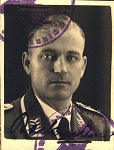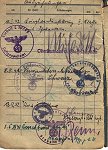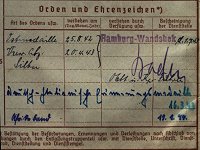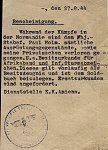
by COL Scott Pritchett
AWARD INSTITUTION
The AFRIKA cufftitle was instituted on 15 January 1943 per Allgemeine Heeresmitteilungen No. 60, dated 27 January 1943. As a campaign decoration, it was considered an award and all branches of the Wehrmacht who met the requirements were entitled to receive the award. While campaign awards (ärmelbander) and unit and traditions (ärmelstreifen) titles tend to be referred to collectively as cufftitles amongst the collecting community, as a true combat award, "ärmelbänder"(cuffband) is the proper name for the AFRIKA title. It should be noted that pictures of Waffen SS soldiers wearing the cuffband are almost invariably Wehrmacht members who had transferred from the Heer, Luftwaffe or Kriegsmarine in to the Waffen SS after serving in the North African theater, although sources indicate that a small detachment of the Allgemeine SS were stationed in Tunis.
To be eligible, a member had to have served in North Africa for at least six months. However, if the individual was wounded in action, the six-month time requirement need not apply.
Individuals who were incapacitated through acquiring one of the many diseases prevalent to men fighting in the harsh desert environment, only had to meet a three-month time requirement. The requirements were modified several times. First, effective 7 July 1943 by authority of Allgemeine Heeresmitteilungen No. 544, individuals who were members of Heeresgruppe Afrika that fought the final phases of the North African campaign were to receive the award if they had served at least four months in theater. The basic criteria were again modified on 1 July 1944 with the issuance of Allgemeine Heeresmitteilungen No. 27. This new criteria made eligible those individuals who had already been awarded the Iron Cross, German Cross in Gold, or who had their name entered in to the Honor Roll of the German Armed Forces. While no direct reference has been found regarding any higher awards also being considered as grounds for automatic bestowal of the AFRIKA cuffband, it would seem to make sense that receiving the Knights Cross would also qualify the recipient. Perhaps the relative rarity of the awarding of the KC with respect to the lesser valor awards made it not worth mentioning or was considered as taken for granted in the crafting of this regulation. The final modification came in Allgemeine Heeresmitteilungen No. 576, dated 21 October 1944 and established that no further awards would be made after 31 October 1944. However, this order allowed exceptions to be made for prisoners of war and in cases, upon written request, on behalf of servicemen missing in action whose remains had been recovered.
Although instituted 15 January 1943, it is unlikely that more than a handful of awards were issued in North Africa before the general surrender on 6 May 1943 and the final capitulation on 13 May. The few short months between institution and capitulation would have been insufficient for the manufacture and distribution to North Africa of the cuffband. This would certainly have been made all the more difficult by the tenuous supply line through the Mediterranean and the challenges faced by the German forces in their final weeks of battle. Earliest known awards show as having been made in May 1943 and these seem to have all been made to Luftwaffe personnel who were probably members of Luftwaffe units stationed in or already evacuated to Italy and Sicily, as the award documents show a facsimilie of Fieldmarshall Kesselring's signature, who at the time was the Supreme Commander of the Southern theater. However, in the eighteen months that followed the end of the North African campaign, the approximately 100,000 men who had served in the theater and were located in Europe at the time of the surrender were tracked down by the OKW and, those eligible, received the award. These men were, for the most part, wounded or ill veterans who had by this time been transferred to other units in other theaters. Others were on leave, being unable to return to their units fighting their last battles in Tunisia, or who had earlier been transferred out of North Africa. The awards were usually made under the name of Army Group Africa (Heeresgruppe Afrika). These former members were tracked down all the way through 1944. Below is an example of an officer who arrived in theater as a replacement, served, was wounded, returned to Germany to heal, and was later tracked down and notified of the award of the AFRIKA campaign cuffband.
![]()
© Copyright Wehrmacht-Awards.com LLC |




